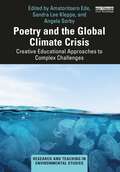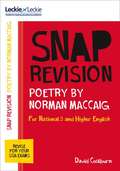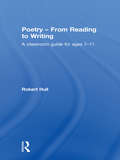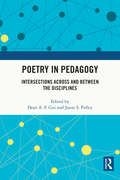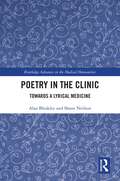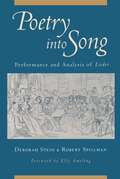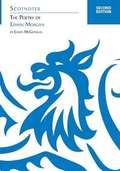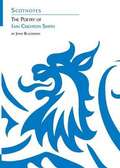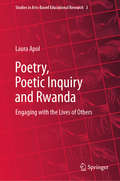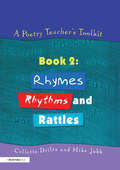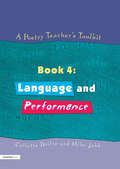- Table View
- List View
Poetry and the 3-11 Curriculum: Enhancing the Learning Experience
by Virginia BowerPoetry can enable learners to engage, learn and have fun, whatever their cognitive, linguistic or social levels and this book provides a great many examples of how this might be achieved. This exciting and innovative text provides a wide range of ideas for using poetry to enhance the early years and primary curricula, and therefore the learning experience of all children. Each chapter contains ideas for pedagogy and practice, underpinned by research and classroom experience ensuring that practitioners will come away feeling much more confident to teach this genre and better enjoy poetry themselves. Throughout, there are discussions around specific pedagogies and practices relating to the use of poetry across the curriculum, as well as resources – including a wide range of poems from diverse countries and cultures and poems in different languages – and activities which can immediately be used in the classroom. Ideas are provided in terms of how poems can be employed in different subject areas, to introduce or reinforce concepts, engage children in more challenging concepts, ensure that lessons are fun and engaging and develop children’s awareness of other people and places beyond their immediate experience. This book is an extremely powerful combination of informed discussion – drawing on ideas from different theoretical perspectives including recent findings from neuroscience – and practical suggestions for every classroom. Armed with this text, practitioners will not only have a very strong idea of how to use poetry to enhance their curriculum but also why this is such a compelling genre.
Poetry and the 3-11 Curriculum: Enhancing the Learning Experience
by Virginia BowerPoetry can enable learners to engage, learn and have fun, whatever their cognitive, linguistic or social levels and this book provides a great many examples of how this might be achieved. This exciting and innovative text provides a wide range of ideas for using poetry to enhance the early years and primary curricula, and therefore the learning experience of all children. Each chapter contains ideas for pedagogy and practice, underpinned by research and classroom experience ensuring that practitioners will come away feeling much more confident to teach this genre and better enjoy poetry themselves. Throughout, there are discussions around specific pedagogies and practices relating to the use of poetry across the curriculum, as well as resources – including a wide range of poems from diverse countries and cultures and poems in different languages – and activities which can immediately be used in the classroom. Ideas are provided in terms of how poems can be employed in different subject areas, to introduce or reinforce concepts, engage children in more challenging concepts, ensure that lessons are fun and engaging and develop children’s awareness of other people and places beyond their immediate experience. This book is an extremely powerful combination of informed discussion – drawing on ideas from different theoretical perspectives including recent findings from neuroscience – and practical suggestions for every classroom. Armed with this text, practitioners will not only have a very strong idea of how to use poetry to enhance their curriculum but also why this is such a compelling genre.
Poetry and the Global Climate Crisis: Creative Educational Approaches to Complex Challenges (Research and Teaching in Environmental Studies)
by Amatoritsero Ede Sandra Lee Kleppe Angela SorbyThis book demonstrates how humans can become sensitized to, and intervene in, environmental degradation by writing, reading, analyzing, and teaching poetry. It offers both theoretical and practice-based essays, providing a diversity of approaches and voices that will be useful in the classroom and beyond. The chapters in this edited collection explore how poetry can make readers climate-ready and climate-responsive through creativity, empathy, and empowerment. The book encompasses work from or about Oceania, Africa, Europe, North America, Asia, and Antarctica, integrating poetry into discussions of specific local and global issues, including the value of Indigenous responses to climate change; the dynamics of climate migration; the shifting boundaries between the human and more-than-human world; the ecopoetics of the prison-industrial complex; and the ongoing environmental effects of colonialism, racism, and sexism. With numerous examples of how poetry reading, teaching, and learning can enhance or modify mindsets, the book focuses on offering creative, practical approaches and tools that educators can implement into their teaching and equipping them with the theoretical knowledge to support these. This volume will appeal to educational professionals engaged in teaching environmental, sustainability, and development topics, particularly from a humanities-led perspective.
Poetry and the Global Climate Crisis: Creative Educational Approaches to Complex Challenges (Research and Teaching in Environmental Studies)
This book demonstrates how humans can become sensitized to, and intervene in, environmental degradation by writing, reading, analyzing, and teaching poetry. It offers both theoretical and practice-based essays, providing a diversity of approaches and voices that will be useful in the classroom and beyond. The chapters in this edited collection explore how poetry can make readers climate-ready and climate-responsive through creativity, empathy, and empowerment. The book encompasses work from or about Oceania, Africa, Europe, North America, Asia, and Antarctica, integrating poetry into discussions of specific local and global issues, including the value of Indigenous responses to climate change; the dynamics of climate migration; the shifting boundaries between the human and more-than-human world; the ecopoetics of the prison-industrial complex; and the ongoing environmental effects of colonialism, racism, and sexism. With numerous examples of how poetry reading, teaching, and learning can enhance or modify mindsets, the book focuses on offering creative, practical approaches and tools that educators can implement into their teaching and equipping them with the theoretical knowledge to support these. This volume will appeal to educational professionals engaged in teaching environmental, sustainability, and development topics, particularly from a humanities-led perspective.
Poetry By Norman Maccaig (Leckie And Leckie Snap Revision Ser. (PDF))
by David CockburnExam Board: SQA Level: N5/Higher Subject: English First teaching: September 2018; First exams: May 2019 Revise N5/Higher English in a snap. Need extra help with 'Poetry by Norman MacCaig', ahead of the exam? Revise and review your understanding of themes, structure and poetic techniques with this handy A5, exam-focused guide. With lots of practice and tips for your SQA exam, this 'Poetry by Norman MacCaig Snap Revision Text Guide' contains all the key information you need to get a top mark.
Poetry - From Reading to Writing: A Classroom Guide for Ages 7-11
by Robert HullPoetry – From Reading to Writing covers the process of writing poetry, from reading poems through to writing them. It is intended particularly for teachers at key stage 2 level, but other teachers will also find it valuable. It is clearly and accessibly written and jargon-free. In providing a wealth of practical ideas and activities preparing for the writing of poems, the book also stresses the use of talk, improvised drama and the reading and performance of poems. The author, who has published four collections of poetry, uses his own work and the work of others to explore how creative readings of poems can spark a child’s imagination and lead to original writing. Pupils are encouraged throughout the book to explore different forms of poetry, including: Rhyming and non-rhyming poems Riddles Short poems Haiku, tanka, renga Poems from stories Free verse Narrative poems Poems drawing on current affairs and history This book can be used by both pupils and teachers, and contains motivating tasks and tips to build pupils’ confidence in poetry writing. Explicit links are made throughout to the latest primary framework for literacy, making this an invaluable resource for all practising and trainee teachers who wish to teach poetry in the classroom in a creative and enjoyable way.
Poetry - From Reading to Writing: A Classroom Guide for Ages 7-11
by Robert HullPoetry – From Reading to Writing covers the process of writing poetry, from reading poems through to writing them. It is intended particularly for teachers at key stage 2 level, but other teachers will also find it valuable. It is clearly and accessibly written and jargon-free. In providing a wealth of practical ideas and activities preparing for the writing of poems, the book also stresses the use of talk, improvised drama and the reading and performance of poems. The author, who has published four collections of poetry, uses his own work and the work of others to explore how creative readings of poems can spark a child’s imagination and lead to original writing. Pupils are encouraged throughout the book to explore different forms of poetry, including: Rhyming and non-rhyming poems Riddles Short poems Haiku, tanka, renga Poems from stories Free verse Narrative poems Poems drawing on current affairs and history This book can be used by both pupils and teachers, and contains motivating tasks and tips to build pupils’ confidence in poetry writing. Explicit links are made throughout to the latest primary framework for literacy, making this an invaluable resource for all practising and trainee teachers who wish to teach poetry in the classroom in a creative and enjoyable way.
Poetry in Pedagogy: Intersections Across and Between the Disciplines
by Dean A. F. Gui Jason S. PolleyThe essays compiled in Poetry in Pedagogy: Intersections Across and Between the Disciplines offer praxes of poetry that cultivate a community around students, language, and writing, while presenting opportunities to engage with new texts, new textual forms, and new forms of text-mediated learning. The volume considers, combines, and complements multiform poetry within and beyond existing Teaching & Learning paradigms as it traverses Asia, The Atlantic, and Virtual Space. By virtue of its mélange of intersecting trajectories, across and between oceans, genres, disciplines, and sympathies, Poetry in Pedagogy informs interdisciplinary educators and practitioners of creative writing & poetry involved in examining the multiform through international, cross-disciplinary contexts.
Poetry in Pedagogy: Intersections Across and Between the Disciplines
by Dean A. F. Gui Jason S. PolleyThe essays compiled in Poetry in Pedagogy: Intersections Across and Between the Disciplines offer praxes of poetry that cultivate a community around students, language, and writing, while presenting opportunities to engage with new texts, new textual forms, and new forms of text-mediated learning. The volume considers, combines, and complements multiform poetry within and beyond existing Teaching & Learning paradigms as it traverses Asia, The Atlantic, and Virtual Space. By virtue of its mélange of intersecting trajectories, across and between oceans, genres, disciplines, and sympathies, Poetry in Pedagogy informs interdisciplinary educators and practitioners of creative writing & poetry involved in examining the multiform through international, cross-disciplinary contexts.
Poetry in the Clinic: Towards a Lyrical Medicine (Routledge Advances in the Medical Humanities)
by Alan Bleakley Shane NeilsonThis book explores previously unexamined overlaps between the poetic imagination and the medical mind. It shows how appreciation of poetry can help us to engage with medicine in more intense ways based on ‘defamiliarising’ old habits and bringing poetic forms of ‘close reading’ to the clinic. Bleakley and Neilson carry out an extensive critical examination of the well-established practices of narrative medicine to show that non-narrative, lyrical poetry does different kind of work, previously unexamined, such as place eclipsing time. They articulate a groundbreaking ‘lyrical medicine’ that promotes aesthetic, ethical and political practices as well as noting the often-concealed metaphor cache of biomedicine. Demonstrating that ambiguity is a key resource in both poetry and medicine, the authors anatomise poetic and medical practices as forms of extended and situated cognition, grounded in close readings of singular contexts. They illustrate structural correspondences between poetic diction and clinical thinking, such as use of sound and metaphor. This provocative examination of the meaningful overlap between poetic and clinical work is an essential read for researchers and practitioners interested in extending the reach of medical and health humanities, narrative medicine, medical education and English literature.
Poetry in the Clinic: Towards a Lyrical Medicine (Routledge Advances in the Medical Humanities)
by Alan Bleakley Shane NeilsonThis book explores previously unexamined overlaps between the poetic imagination and the medical mind. It shows how appreciation of poetry can help us to engage with medicine in more intense ways based on ‘defamiliarising’ old habits and bringing poetic forms of ‘close reading’ to the clinic. Bleakley and Neilson carry out an extensive critical examination of the well-established practices of narrative medicine to show that non-narrative, lyrical poetry does different kind of work, previously unexamined, such as place eclipsing time. They articulate a groundbreaking ‘lyrical medicine’ that promotes aesthetic, ethical and political practices as well as noting the often-concealed metaphor cache of biomedicine. Demonstrating that ambiguity is a key resource in both poetry and medicine, the authors anatomise poetic and medical practices as forms of extended and situated cognition, grounded in close readings of singular contexts. They illustrate structural correspondences between poetic diction and clinical thinking, such as use of sound and metaphor. This provocative examination of the meaningful overlap between poetic and clinical work is an essential read for researchers and practitioners interested in extending the reach of medical and health humanities, narrative medicine, medical education and English literature.
Poetry into Song: Performance and Analysis of Lieder
by Deborah Stein Robert SpillmanFocusing on the music of the great song composers--Schubert, Schumann, Brahms, Wolf, and Strauss--Poetry Into Song offers a systematic introduction to the performance and analysis of Lieder . Part I, "The Language of Poetry," provides chapters on the themes and imagery of German Romanticism and the methods of analysis for German Romantic poetry. Part II, "The Language of the Performer," deals with issues of concern to performers: texture, temporality, articulation, and interpretation of notation and unusual rhythm accents and stresses. Part III provides clearly defined analytical procedures for each of four main chapters on harmony and tonality, melody and motive, rhythm and meter, and form. The concluding chapter compares different settings of the same text, and the volume ends with several appendices that offer text translations, over 40 pages of less accessible song scores, a glossary of technical terms, and a substantial bibliography. Directed toward students in both voice and theory, and toward all singers, the authors establish a framework for the analysis of song based on a process of performing, listening, and analyzing, designed to give the reader a new understanding of the reciprocal interaction between performance and analysis. Emphasizing the masterworks, the book features numerous poetic texts, as well as a core repertory of songs. Examples throughout the text demonstrate points, while end of chapter questions reinforce concepts and provide opportunities for directed analysis. While there are a variety of books on Lieder and on German Romantic poetry, none combines performance, musical analysis, textual analysis, and the interrelation between poetry and music in the systematic, thorough way of Poetry Into Song.
Poetry into Song: Performance and Analysis of Lieder
by Deborah Stein Robert SpillmanFocusing on the music of the great song composers--Schubert, Schumann, Brahms, Wolf, and Strauss--Poetry Into Song offers a systematic introduction to the performance and analysis of Lieder . Part I, "The Language of Poetry," provides chapters on the themes and imagery of German Romanticism and the methods of analysis for German Romantic poetry. Part II, "The Language of the Performer," deals with issues of concern to performers: texture, temporality, articulation, and interpretation of notation and unusual rhythm accents and stresses. Part III provides clearly defined analytical procedures for each of four main chapters on harmony and tonality, melody and motive, rhythm and meter, and form. The concluding chapter compares different settings of the same text, and the volume ends with several appendices that offer text translations, over 40 pages of less accessible song scores, a glossary of technical terms, and a substantial bibliography. Directed toward students in both voice and theory, and toward all singers, the authors establish a framework for the analysis of song based on a process of performing, listening, and analyzing, designed to give the reader a new understanding of the reciprocal interaction between performance and analysis. Emphasizing the masterworks, the book features numerous poetic texts, as well as a core repertory of songs. Examples throughout the text demonstrate points, while end of chapter questions reinforce concepts and provide opportunities for directed analysis. While there are a variety of books on Lieder and on German Romantic poetry, none combines performance, musical analysis, textual analysis, and the interrelation between poetry and music in the systematic, thorough way of Poetry Into Song.
Poetry Mentor Texts: Making Reading and Writing Connections, K-8
by Lynne Dorfman Rose CappelliBuilding on the success of Mentor Texts and Nonfiction Mentor Texts, authors Lynne R. Dorfman and Rose Cappelli now turn their attention to poetry. In Poetry Mentor Texts , Lynne and Rose show teachers how to use poems in both reading and writing workshops and across content areas. Written in a friendly, conversational tone, this practical book explores a variety of poetic forms, including poems that inspire response, list poems, acrostic poems, persona poems, and poems for two voices-;versatile forms of poetry that can be used in every grade. Each of these poetic forms has its own chapter featuring five poems with applications for both reading and writing classrooms. Reading connections present skills and strategies to move students forward as readers, helping them to build fluency, vocabulary, comprehension, phonemic awareness, and phonics. Writing connections help students and teachers discover their own voices and grow as poets and wordsmiths as they try out many poetic forms. Poems help students at all grade levels learn to better address complex reading texts, offering them a chance to dig deeper and use higher-order thinking skills. Additionally, Your Turn writing lessons provide a scaffold for seamlessly moving from modeling to the shared or guided experience and the transfer to independent work. The Treasure Chest offers a brief annotation of the poems discussed in each chapter as well as companion pieces that extend and enhance the work of the reading and writing classroom. Poetry Mentor Texts helps teachers across the curriculum guide their students to become not only skilled readers and writers but also more empathetic human beings.
Poetry Mentor Texts: Making Reading and Writing Connections, K-8
by Lynne Dorfman Rose CappelliBuilding on the success of Mentor Texts and Nonfiction Mentor Texts, authors Lynne R. Dorfman and Rose Cappelli now turn their attention to poetry. In Poetry Mentor Texts , Lynne and Rose show teachers how to use poems in both reading and writing workshops and across content areas. Written in a friendly, conversational tone, this practical book explores a variety of poetic forms, including poems that inspire response, list poems, acrostic poems, persona poems, and poems for two voices-;versatile forms of poetry that can be used in every grade. Each of these poetic forms has its own chapter featuring five poems with applications for both reading and writing classrooms. Reading connections present skills and strategies to move students forward as readers, helping them to build fluency, vocabulary, comprehension, phonemic awareness, and phonics. Writing connections help students and teachers discover their own voices and grow as poets and wordsmiths as they try out many poetic forms. Poems help students at all grade levels learn to better address complex reading texts, offering them a chance to dig deeper and use higher-order thinking skills. Additionally, Your Turn writing lessons provide a scaffold for seamlessly moving from modeling to the shared or guided experience and the transfer to independent work. The Treasure Chest offers a brief annotation of the poems discussed in each chapter as well as companion pieces that extend and enhance the work of the reading and writing classroom. Poetry Mentor Texts helps teachers across the curriculum guide their students to become not only skilled readers and writers but also more empathetic human beings.
The Poetry Of Edwin Morgan (Scotnotes Study Guides #2)
by James McGonigalEdwin Morgan (1920–2010) is one of the giants of modern poetry. Scotland’s national poet from 2004 to his death in 2010, he produced an astonishing range of work, from the playful to the profound. James McGonigal’s Second Edition of this Scotnote (2013) covers the entirety of Morgan’s work throughout the poet’s long and hugely productive life, and is an ideal guide for senior school pupils and students to Morgan’s overflowing creativity.
Poetry Of Iain Crichton Smith (Scotnotes Ser. #No. 8)
by John BlackburnIain Crichton Smith was one of the foremost poets of the 20th century, writing in English and Gaelic. His poetry often concerns itself with unsentimental views of life in the Western Highlands and Islands, and his dislike of, and opposition to, dogmatic authority. John Blackburn’s Scotnote analyses the religious, political and historical themes and patterns of Crichton Smith’s work, and is a suitable guide for senior school pupils and students at all levels.
A Poetry Pedagogy for Teachers: Reorienting Classroom Literacy Practices
by Maya Pindyck Ruth Vinz Diana Liu Ashlynn WittchowA Poetry Pedagogy for Teachers generates imaginative encounters with poetry and invites educators to practice a range of poetry exercises in order to inform instructional approaches to reading and writing. Guided by pedagogical principles prompted by their readings of Wallace Stevens' “Thirteen Ways of Looking at a Blackbird,” Maya Pindyck and Ruth Vinz provide critical discussion of prominent literacy practices in secondary classrooms and offer alternative approaches to encountering a text. They do this by way of experimental readings of Wallace Stevens' poem toward a set of thirteen pedagogical principles that anchor a pedagogy of poetic practices. The book also offers invitational exercises, the authors' own engagements with poetry practices, as well as student examples, visual modes of theorizing, and a gathering of relevant resources compiled by two classroom teachers. This is a book for secondary English teachers, teaching artists, English educators, college writing professors, readers and writers of poetry – both existing and aspirational – and any educator interested in poetry's capacities to pedagogically inform their subject matter and/or literacy practices.
A Poetry Pedagogy for Teachers: Reorienting Classroom Literacy Practices
by Maya Pindyck Ruth Vinz Diana Liu Ashlynn WittchowA Poetry Pedagogy for Teachers generates imaginative encounters with poetry and invites educators to practice a range of poetry exercises in order to inform instructional approaches to reading and writing. Guided by pedagogical principles prompted by their readings of Wallace Stevens' “Thirteen Ways of Looking at a Blackbird,” Maya Pindyck and Ruth Vinz provide critical discussion of prominent literacy practices in secondary classrooms and offer alternative approaches to encountering a text. They do this by way of experimental readings of Wallace Stevens' poem toward a set of thirteen pedagogical principles that anchor a pedagogy of poetic practices. The book also offers invitational exercises, the authors' own engagements with poetry practices, as well as student examples, visual modes of theorizing, and a gathering of relevant resources compiled by two classroom teachers. This is a book for secondary English teachers, teaching artists, English educators, college writing professors, readers and writers of poetry – both existing and aspirational – and any educator interested in poetry's capacities to pedagogically inform their subject matter and/or literacy practices.
Poetry, Poetic Inquiry and Rwanda: Engaging with the Lives of Others (Studies in Arts-Based Educational Research #3)
by Laura ApolThis book describes the practice of poetic inquiry and takes the reader through the process of translating lived experience into poetry that attends to the lives of others. Using her own writing—from early drafts to published poems—Apol demonstrates elements of poetic inquiry that both give it strength and make it complicated: the importance of craft (the aesthetic); the imperative of accuracy and reliability (the investigative); the significance of ethical responsibility that leads to action (witness); and the centrality of relational connectedness and accountability (withness). Apol raises questions about what it means for poems to function as both research and art, and illustrates what happens when there are irresolvable conflicts between the demands of the poem and a commitment to relationship. Throughout, Apol addresses her white privilege, as well as the dominant white/colonial narrative that often seeps into arts-based work unless it is overtly and critically addressed. The book goes beyond arts-based research, speaking as well to other forms of cross-national, cross-cultural research. It is a call for relational scholarship that moves toward action, a heart-rending teaching, a post-traumatic aesthetic map laid down with clear and poignant theory and praxis to extend, serve and guide.
Poetry The Student Toolkit Literary Eye GCSE English Second Edition (PDF)
by Steve EddyThe student guide to how poetry works and responding to poetry.
A Poetry Teacher's Toolkit: Book 2: Rhymes, Rhythms and Rattles
by Collette Drifte Mike JubbProfessional poets spend many hours crafting a finished piece of work, yet we expect children in school to sit down and write when they are told to, whether they feel inspired or not. This series of four books is a toolkit to help you build a positive framework for children to read, write, understand and enjoy poetry - to bring a creative spark to the poetry classroom. A combination of featured poems, creative ideas, structured lesson plans and differentiated photocopiable activity sheets gives the series a uniquely flexible approach - which means you can use the materials in any classroom context. If you're wary of poetry, if you think it's boring, or if you're nervous about teaching poetry, then you've chosen the right book. Key themes covered in BOOK 2: Rhymes, Rhythms and Rattles are rhythm and rhyme in poetry, sounds, alliteration, words to create effects, onomatopoeia, and metaphor and simile. Other books in the series are: BOOK 1: Words and Wordplay; BOOK 3: Style, Shape and Structure; and BOOK 4: Language and Performance.
A Poetry Teacher's Toolkit: Book 4: Language and Performance
by Collette Drifte Mike JubbProfessional poets spend many hours crafting a finished piece of work, yet we expect children in school to sit down and write when they are told to, whether they feel inspired or not. This series of four books is a toolkit to help you build a positive framework for children to read, write, understand and enjoy poetry - to bring a creative spark to the poetry classroom. A combination of featured poems, creative ideas, structured lesson plans and differentiated photocopiable activity sheets gives the series a uniquely flexible approach - which means you can use the materials in any classroom context. If you're wary of poetry, if you think it's boring, or if you're nervous about teaching poetry, then you've chosen the right book. Key themes covered in BOOK 4: Language and Performance are moods and feelings through the use of effective language; nonsense and humorous verse; the continuity and links between ancient and modern, between nursery and playground rhymes and Shakespeare; whatever our ability, there is a place for everyone on the poetry 'ladder'; and performance poetry. Other books in the series are: BOOK 1: Words and Wordplay; BOOK 2: Rhymes, Rhythms and Rattles; and BOOK 3: Style, Shape and Structure.
A Poetry Teacher's Toolkit: Book 4: Language and Performance
by Collette Drifte Mike JubbProfessional poets spend many hours crafting a finished piece of work, yet we expect children in school to sit down and write when they are told to, whether they feel inspired or not. This series of four books is a toolkit to help you build a positive framework for children to read, write, understand and enjoy poetry - to bring a creative spark to the poetry classroom. A combination of featured poems, creative ideas, structured lesson plans and differentiated photocopiable activity sheets gives the series a uniquely flexible approach - which means you can use the materials in any classroom context. If you're wary of poetry, if you think it's boring, or if you're nervous about teaching poetry, then you've chosen the right book. Key themes covered in BOOK 4: Language and Performance are moods and feelings through the use of effective language; nonsense and humorous verse; the continuity and links between ancient and modern, between nursery and playground rhymes and Shakespeare; whatever our ability, there is a place for everyone on the poetry 'ladder'; and performance poetry. Other books in the series are: BOOK 1: Words and Wordplay; BOOK 2: Rhymes, Rhythms and Rattles; and BOOK 3: Style, Shape and Structure.

